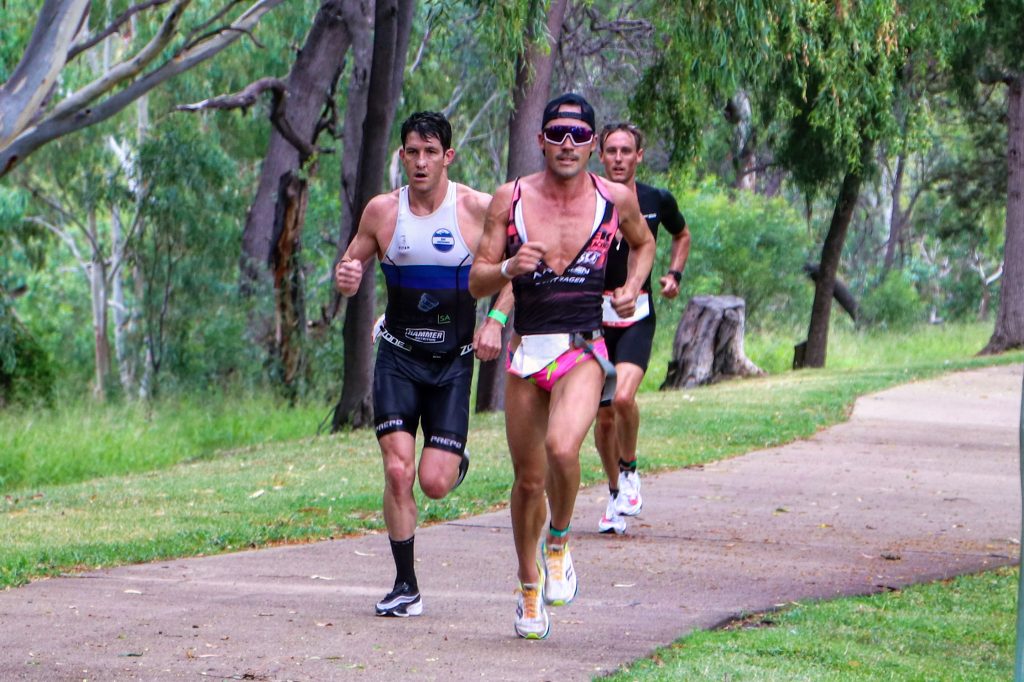
PREFACE: You’re welcome to skip to the shoes..
This is not the sort of blog you would read start to finish. Life is too short. Simply scroll until you find a shoe you’re curious about and then move on with your life. I’ll continually add shoes as I get to round to it and/or try new releases eventually enabling a search function so you don’t have to scroll endlessly.
If you came here to witness me tear to shreds the brilliant minds behind the multitude of shoe designs out there I feel you’ll be disappointed. Like a fine French wine connoisseur, I’m not interested in trying shoes that I’m quite certain won’t work for me or are not high performance footwear. I’m comparing really good running shoes with really good running shoes. If you’re chasing advice on heavy duty, long lasting trainers, reading anything beyond this point will be precious minutes of your life lost, never to be reclaimed. Even if you read on, that could still be the case.
Running shoes are like aero helmets in that what works for one person might test poorly for another. So just because an overly opinionated vertically challenged pro triathlete states shoe opinions like it’s gospel on the shoes below, they are just that, opinions. The total opposite of what I look for in a shoe might be better for you.
To help you decide whether my palate is akin to yours, I’m 170cm tall on a warm day and range from 62 to 68kgs depending on whether I’m in a zero or high beer consumption phase of my training program. I’m a high arched, neutral runner with very little pronation. Probably too little pronation leading to quite a high impact on foot strike. If I could opt for some biological changes, I would add a little to my ankle pronation, although that would be way further down the list after an extra 20cm of height and a less manic brain.
My running shoe obsession has plagued me as long as I can remember. My childhood was spent cutting apart my worn out basketball and running shoes to see how they were all put together. The passion continued (shoes, not cutting stuff up) through university as I worked in a running shoe shop to pay my way through life. That worked out terribly work as I would trade in my weekly pay for another pair of shoes to run in. This consistent cash splashing on shoes resulted in several years surviving exclusively on baked beans toasted sangers and necessitated taking on a second job washing dishes at night to pay my rent. The only upside of hours of gait analysis and personally trialling hundreds of shoes was that now as a 35 year old I can waste a few hours of my life writing shoe reviews to avoid doing other tasks that actually need to be completed.
Three important points.
- I’m not currently aligned with any shoe companies. Sometimes I get sent freebies to try but in no way does that influence my opinion on them. Perhaps this is foolish as this could end the free shoe deliveries. Perhaps clever because now people will understand I won’t be sponsored by a shoe company unless they’re really bloody awesome shoes. If I do become partner up with a brand, I’ll stop adding to this blog.
- My shoe efficiency testing methods involve the standard but less preferable heart rate for pace treadmill testing. I say less preferable because shoes that really bounce you up in the air like the Nike Next % will always test very well on a treadmill as it allows more time for the treadmill belt to run underneath you but in the real world these vertical hang time moments do not necessarily result in a faster forward motion. The other testing is of course out in the big bad real world involving 1-5km looped flat or undulating repeats with the pace ranging from goal middle distance triathlon to Ironman pace as per the treadmill testing, comparing heart rate or doing the intervals at a set heart rate to compare pace. I keep an eye on weight loss, temperature, wind speed and other variables while cycling through the shoes several times in a testing session, so that heart rate creep and other potential factors can be somewhat excluded. What I’ve found interesting is that shoes that are really efficient at 3.15/km pace are not always the fastest at 4 min/km pace. Also, what works best in the first 5kms may not be as good 15-20kms into the testing as run form changes with fatigue. For those that want to pick apart the lack of controls with the testing you’ll get no argument from me. It’s far from perfect. Your personal results could be different so get out there and do hundreds of kilometres of testing, and swapping shoes every 1-5 kms while controlling more variables. You have my full support.
- Glossary of terms at the bottom of the blog.
- Also included is a list of shoes that will be reviewed soon. Shoot me a message on FB or Insta of a shoe that you would like reviewed. If enough people ask, it will give me an excuse to buy more shoes for testing.
Nike Air Zoom Alphafly NEXT%- Purchased
Nike Alphafly Next % 9.5/10
Nike have tamed the wild brumby while keeping, if not improving, the speed inherited from it’s royal ancestors but if you’re looking for a shoe that will last beyond a 2-3 races. Look elsewhere.
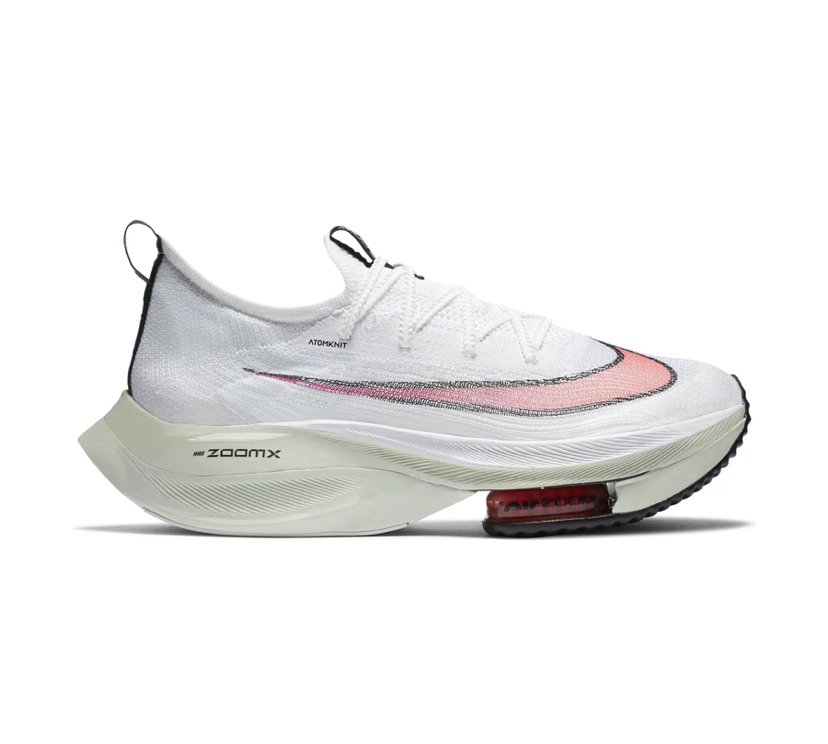
This shoe took longer than other shoe to review. I think because deep down, I really wanted to dislike it. It’s hard to disregard subconscious bias but I think I’ve managed when I say, dammit, I love this shoe.
Finally Nike have included some more meat on the medial side of the shoe to halt the hectic over-pronation of their previous top racing shoes. Coupled with the air pods in the forefoot of the shoe the stability is a drastic improvement from the Vaporfly Next %. volume. That’s not to say they’re stable in the way the Saucony Endorphin Pro or Sketchers Speed Elite are. Far from it but definitely many times safer on the achilles, knees and hips than it’s predecessors.
Like all carbon-plated shoes, correct sizing is critical and these trampoline shoes fit very much on the large side; unusually I had to sell my first pair and and purchase another to go down to a size 9 US. For context, I often run in a size 10. Given the cost (currently $370 AUD) I would try before you buy. Like a new car out of the show room, you’ll lose a bucket load trying to sell the pair that doesn’t fit.
On the treadmill these shoes are faster than any other non-Nike shoe by quite a lot. However, treadmill tests in any of the ‘Zoom X’ foam shoes will be very misleading as the shoes hurtle you towards orbiting the moon allowing much more treadmill belt to run underneath you. Take them out on the road and you soon see that an increase in vertical oscillation doesn’t necessarily translate to horizontal speed. However, learning how to use the spring to your advantage by training in the foam and making subtle changes to run technique can help the runner recruit the bounce to a more forward moving advantage.
Is it faster than the Saucony Endorphin Pro? Perhaps but if so, not by much. In objective tests they’re much closer than they feel.
As I’ve often reported, the Zoom X exaggerates great running but also exaggerates sloppy ‘falling apart’ running when the monkey jumps on your back. If you can hold your form together well, I think the biggest perk is how cushioned the shoe is for it’s crazy light mass. This cushioning will lead to fresh muscles late in a marathon where you can really start laying the sword into the competitors around you who are dealing with the ‘glass in quads’ sensation that typically befriends runners from the 25km mark onwards.
Decent width, great loop holes front and back for quick transitions ( I would still wear socks, my feet are in tatters from Husky Tri) and excellent grip in all conditions. Nike have hit this one out of the park.
Longer term additional comment on durability. The durability is offensively bad. The Zoom X foam turns to smoosh a long time before the air pockets on the front so the 4mm drop quickly becomes 2-3mm and you feel like you’re sinking into the back seat of these babies after as little as 100kms of wear. Still, if a single race performance is all you’re chasing, it’s very difficult to look past this creation.
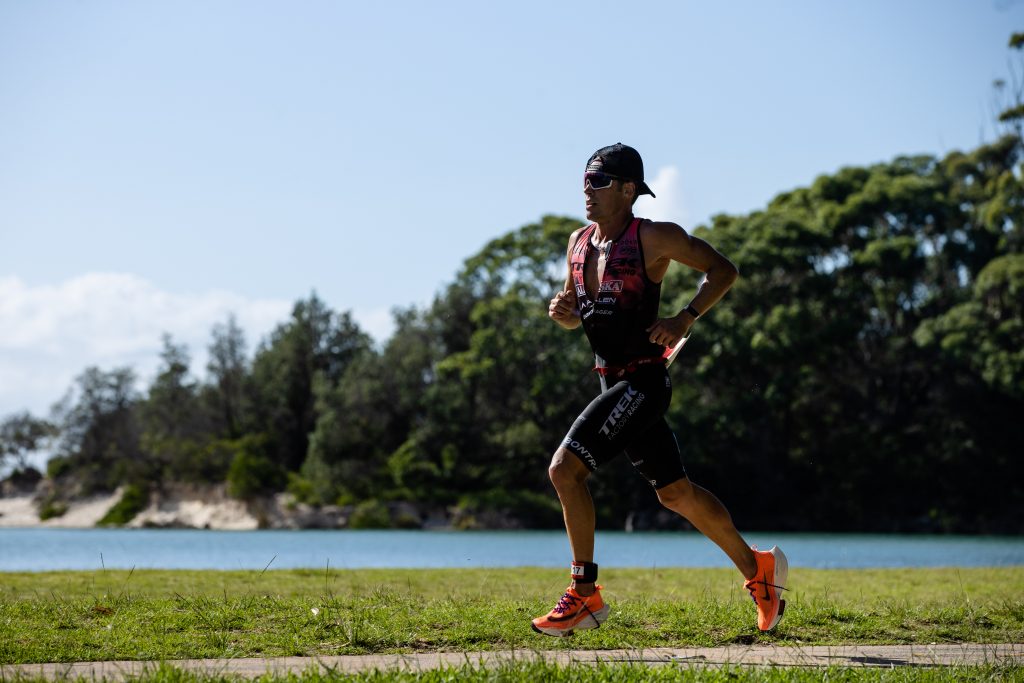
Saucony Endorphin Pro- 9.5/10 Purchased.
Finally, a traditional feeling carbon plated shoe that performs very nearly as efficiently as the best I’ve tested with durability that far exceeds the Nike Alphafly.
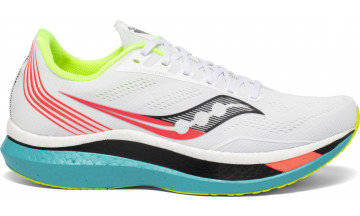
Incredible stability, the right balance between cushioning and responsiveness at 213-220 grams (ish). Finally a shoe where no overhaul of run technique is needed to make this shoe fast and for the runner to stay injury free, unlike some other super fast carbon plated offerings.
Stability matters as you will tell from my Next % review. For years when runners have talked to me with knee pain or hip pain, I’ve recommended a switch to Saucony Kinvara (See hall of fame posted shortly) OR Saucony Zealot because the stability these shoes offered with their wide platform, natural heel to toe drop shakes off the aches and pains with a longer lasting effect than most physiotherapy sessions.
I’m quite sure the ‘PEBA’ foam that the Endorphin Pro, much like the ‘Everlast’ foam in previous Saucony models, is borrowed from Adidas for a tidy commission as it’s far too similar to not be breaching some form of patent. However, who really cares who owns the tech, this foam is the business!
Unusually for such light shoes, you don’t have to pass these on to your unsuspecting, shoe illiterate friends you compete against once the foam has turned to smoosh (5) for the wonderful reason that the foam doesn’t turn to smoosh! The Endorphin Pros dying day will be because the minimal use of the outer sole rubber has worn through. I don’t see any way of making a lightweight racer without a minimal outer sole so when that day comes, shed a tear, but don’t get angry. Either way, unless you run like the heel scuffing line dancing top American pro, Sam Appleton or the bizarrely fast wounded soldier Lionel Sanders, you should get at least 350 kms of running banked before the outer sole has been ground to invisibility. Along with the full length carbon plate, an 8mm drop that seems to work superbly especially for those running off the bike. Combined with the Endorphin Pro’s ’Rocker (1), these features genuinely help this shoe fly.
The one improvement Saucony needs to make is around the heel cup design. It’s not atrocious but there is a lot of room for improvement to prevent heel slippage, rubbing, and to further improve the shoe’s efficiency.
Lace very tightly at the top of the shoe if you want to go sockless while racing without donating some skin to the race course.
Shoe comes in a pleasant design as per image above and in a vomit inducing high vis orange. I would not argue against the death penalty for whoever decided the latter colour design was a good option.
Saucony, if you’re reading, please also add a loop to the rear of your fastest shoes. My fellow triathletes and I would be greatly appreciative in transition 2. In fact, any shoe company reading this, please do this! It adds almost no weight but makes life so much easier for compression sock wearing, garmin gazing Triathlon dorks like myself to get them on in a hurry.
Adidas Adizero Prime X- 9.2/10 Purchased.
Real fast but real weird.
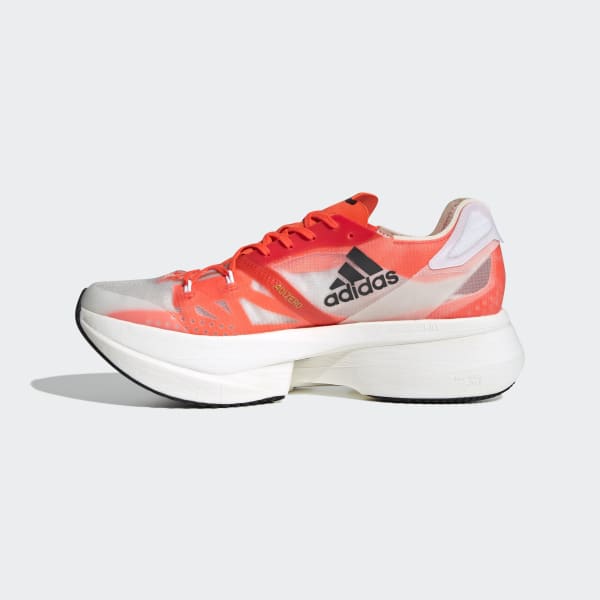
First steps and I felt like a drunk in heels. I miss those days. Anyway, this is some damn tall footwear!
The latest World Athletics rules banned shoes with soles thicker than 40mm making sure that their close buddies at Nike were just under the limit with current designs.
So this design is well and truly illegal for regulated athletic events not only due to it’s 50mm foam stack height but also for it’s highly illicit multiple carbon infused carbon blades instead of the permitted singular use of ‘rigid plate or similar device’.
Instead of ditching this shoe, Adidas likely thought, ‘ahhh there’s still triathlon events where nothing ever seems to get ruled out except 20m drafting rules for pros. Roll out the space boots!’
This shoe is blistering fast. As fast as anything I’ve tested in both treadmill and field tests. However, before you go out and throw a cheeky 4 hundy at the Adidas website.. Adidas have ignored basic physics in the design that even my 3 year old understands when he makes tall towers out of blocks. If you make something higher you need to make the base wider or the structure will fracture and the tower will tumble.
In this case, your legs are the structure that will fracture and you will be the tower that tumbles.
In short, they’re bloody unstable. Not wreck your achilles with an over-pronation effect like the Nike Next % but more in the way they encourage lateral ankle rolls if the runner loses concentration at any moment. If you’re running a race with lots of turns, you’re going to lose time in every turn navigating these running shoe cruise ships around the corners.
Interestingly, where the poor stability seems less of a concern when you’re really up and moving at tempo to threshold intensities.
Tri doggies, you wouldn’t want this upper on your skin without socks. In fact, even with socks the laces dig in a little uncomfortably. On the upper upside, it doesn’t hold much water at all when wet so you can keep throwing that water over your head on the run.
The Continental rubber outsole and ridges really shines in the dry or wet and while I haven’t yet done enough kms to really evaluate the shoes durability I’m seeing already seeing signs that they are going to be much longer lasting than Nike Alphaflys.
The cushioning is obviously next level for the weight and would be amazing for anyone who hasn’t been able to do adequate milage for a running event or tri needing as much quad protection as possible to keep running fast in the latter stages of an event. Provided you never lose foot placement concentration..
Would I race these shoes in certain events without many turns despite the risk of snapping my legs in two? Yeah probably.
Asics EvoRide 9.2/10 Sent to test.
No outstanding weapons but absolutely zero weaknesses at a brilliant price point.
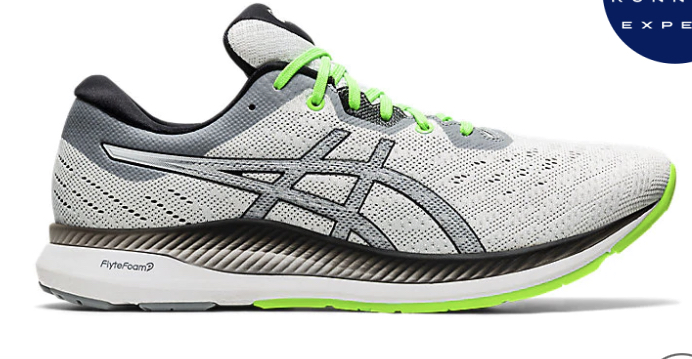
I put in months of training in this shoe without considering how wonderful it was. If you’re not thinking about the shoes that’s a good sign the all is well between foot and shoe is on track and in time the trust builds into a truly beautiful relationship.
The Asics ‘Flight Foam’ is firm but stays cushioned even after hundreds of pavement smacks. The shoe just wants to roll forward with a very pronounced rocker while the 6mm drop blends perfectly with almost all run paces. Because there is no carbon plate and the weight is not crazy light (260 grams) I never really considered it for racing. Only after cycling through shoes in a very long 10 x 3km run test of several shoes was I awakened to how fast the shoe is especially after 15kms when other shoes start to conspire against you in a mutinous fashion as form fades.
Only a few heart rate beats slower the the various carbon offerings. ‘Feel’, while being utterly unscientific, really matters in the later stages of an Ironman when from 20kms you’re in the torture chamber.
Mid level durability as the outer-sole of the shoe will wear out before the brilliant ‘Flight foam’ loses its ‘popability’ (4).
A very high rating for the EvoRide because while it has no outstanding features, the fact it has zero weaknesses, is in itself, outstanding. Factor in that it’s easily $100-$200 cheaper than most other brands top of the line racers and you could bang out a tonne of training runs AND use for race day if you’re not worried about a few saved heart rate beats that a carbon plate can provide often at less comfort. It’s a genuine winner.
Brooks Hyperion Elite 2- 9.1/10 Sent to test.

Like all carbon plated footwear, I had to a very snug pair to make the fit right but once I dialled in the size, I was instantly fond of the ride on offer.
They’re light. 210 grams light (Mens U.S 9) and the 8mm drop is not unnatural in the way other 8-10mm drops can be. I suspect this is because of the way the heel is cut out so you’re not forced into a heel strike like you may be with strong heel extrusion. Very responsive while still feeling cushioned. Not Alphafly cushioned but still a nice level of pushin cushion. I’m quite sure the Nitrogen-infused EVA is the same compound used in Skechers Speed Elite below only there is a lot more of it and that is a good thing. In fact, everything about this shoe reminds me of an improved version of the Skechers below except the wet surface grip has far less traction.
The stability of the wide platform is more than pleasant. The upper is satisfactory but you wouldn’t the upper on your skin without socks acting as the smooth middle man.
Expensive but at least that expense comes with a shoe and base foam that appears to last really well.
The big question is whether the shoe is fast enough to justify the cataract causing fluro base. Most reviewers go for a run and declare the shoe fast or slow based off feel. A woeful speed indicator as ‘feel’ and reality can be very far apart. I thought this shoe was Muhammad Ali pre Vietnam fast based off feel until I did some objective testing and the numbers didn’t lie. It’s certainly very quick but you’re getting comeback Ali. Still winning but because of durability more than outrageous speed.
I would buy because I love the ride, they’re fast without being blazingly fast but most importantly they seem to last and last with my first run a few months ago feeling exactly the same as my run after several hundred kilometres.
Skechers Gorun Speed Elite 9/10. Purchased.
Light, responsive, grip you could hike glaciers with and carbon plate functionality that actually works but the nitrogen infused DNA foam simply doesn’t propel your take off like a few of the other super shoes.
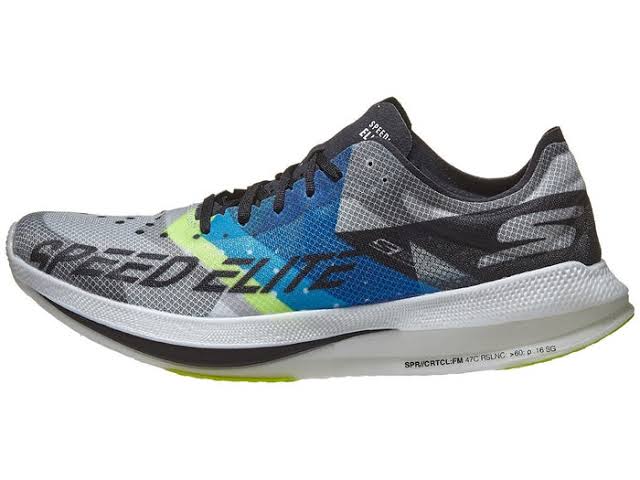
If you slow-mo most people running in carbon plated shoes, what you’ll often see is the carbon plate flexing which simply moves the heel cup up and down while the heel just cops unpleasant heel cup massage. This obviously minimises the carbon plate benefit, which is why I’m so fond of the Sketchers forefoot carbon plate design. The heel stays in place in the shoe while you still get some good carbon plated propulsive goodness as the toes flex and drive at the latter stage of each run stride.
The Good Year grip is a real sticking point in the best possible way. I think the best outer rubber I’ve run in. You plant, grip and rip through every stride without the slightest sign of slippage on all surfaces ranging from a wet triathlon aid station to the greasy cement of a McDonalds drive through.
The foam is a nitrogen infused EVA. It doesn’t rebound like some of the other top end brands foams out there but sometimes I think a shoe can give too much rebound especially at slower speeds where a ‘double bounce effect’ occurs when you’re dying not flying. This foam simply provides nice cushioning on impact and allows a very responsive natural take off, while encouraging a high cadence and delicious run form.
At 160grams for a size 9, the Speed Elite should not be at all durable but defies all expectations showing resilience similar to most shoes tipping the scales at 260 grams.
Only potential downside for some athletes is the 4mm drop. It feels like a 3mm and for those that are used to running in 6-10mm shoes I would ease into this light weight baby rather slowly to ensure the achilles and calves can elongate gradually to get accustomed to it. OR, you can do as I did and simply cut in half an inner sole and glue into the back half of the shoe to make the shoe into a 6mm drop. This may put the heel cup too low on the heel but for myself, it worked fine.
Note – I haven’t done any efficiency testing of this shoe apart from dreamily observing a really good pace for heart rate on runs but I will update when I do so down the track.
Asics Glide Ride 8.9/10 Sent to test.
A truly unique ride. My ‘go-to’ shoe for lots of training especially when the legs are a little Slim Dusty.
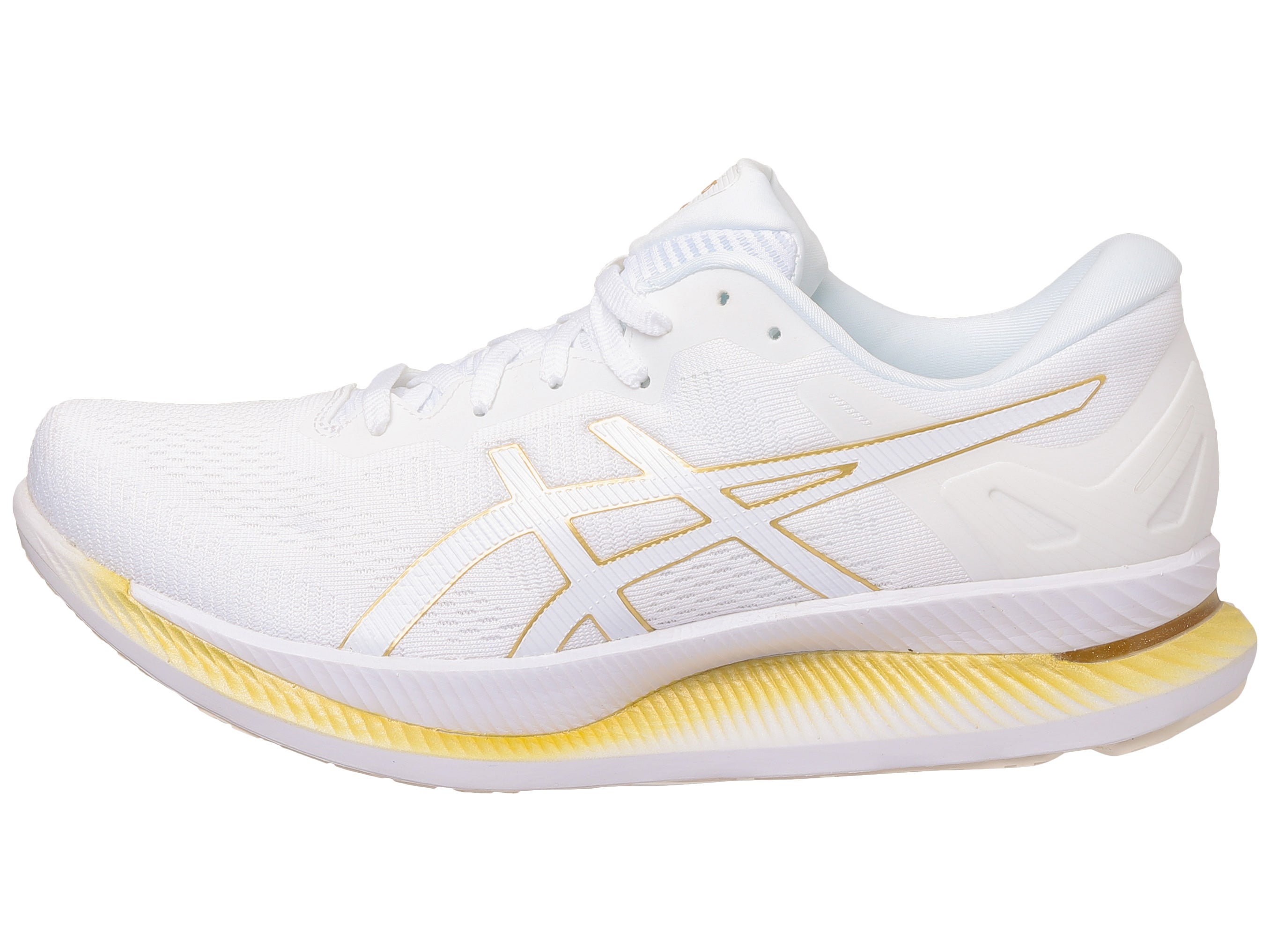
The sole is packed with oodles of the Asics ‘Flight foam’, a foam I have so much affection for. At first sight I was sceptical the strange sole design would work but not only does it work, it really seems to really create an amazing running experience… unless rocks get caught in the big sole wedge cut out. Not really a problem unless you run mainly gravel roads.
An epic rocker combined with this level of cushioning, gel insert in the heel and a 6mm drop make this strange but wonderful beast worthy of including ‘Glide’ into it’s name as you genuinely get that running vibe until offseason kicks off, weight piles on and no amount of shoe super power can ever make you feel like you’re gliding.
Only negative is that the weight of 290 grams, while not heavy for a trainer still makes it a bit too heavy to race in. Perhaps we could see an ‘Asics Glide Ride Light’ version coming in the near future please Asics? High score mainly in regards to a trainer not racer rating and being way cheaper than most of the other shoes reviewed here.
Hoka Carbon X 8.7/10 Gifted (not from Hoka)
Stable and fast due to rocker and great foam tech. Not convinced on how functional the carbon plate is but all in all, Hoka have a shoe that’s a pleasure to run in.
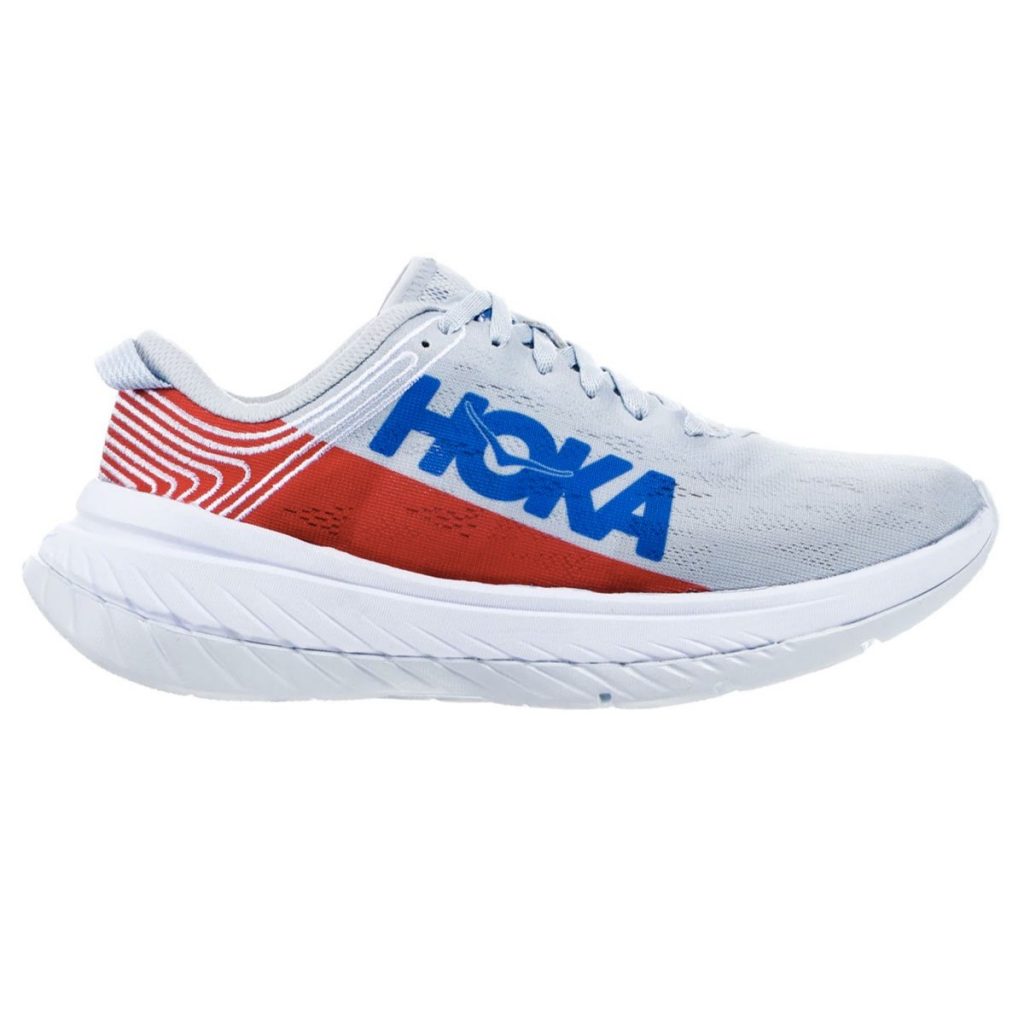
The shoe tests well. Not amongst my top 3 for outright insane free speed but still right up there near the best. Most importantly, I feel good in them after 15kms of fast running unlike some of the shoes that test superbly but feel like you’re doing damage with the unnatural hard to control bounce. Big thumbs up to the wide stable platform that allows this shoe even in a 4mm drop to feel both natural while also kind towards tight calf muscles and achilles tendons.
I suspect the very pronounced ‘rocker’ shape and way the shoes outer-sole isn’t overly cushioned in the forefoot is the big driver of the Carbon X’s efficiency. I’m not convinced the carbon plate design flexes much for forward propulsion however the rigidity of the plate would certainly help the rocker action roll the runner forward.
The carbon X looks like it should be super durable but by 200kms I was pretty much down to the carbon plate in the forefoot, so I would save them for race day or key sessions leading up to that day.
A lot of athletes I know who couldn’t make Nike options work for them were really happy in the Hoka Carbon X and I can see why.
Nike Zoom X Vaporfly Next% 8.2 /10 Purchased
Impure passionate lust soon subsides into the reality that you’re incompatible and true love will never be possible.
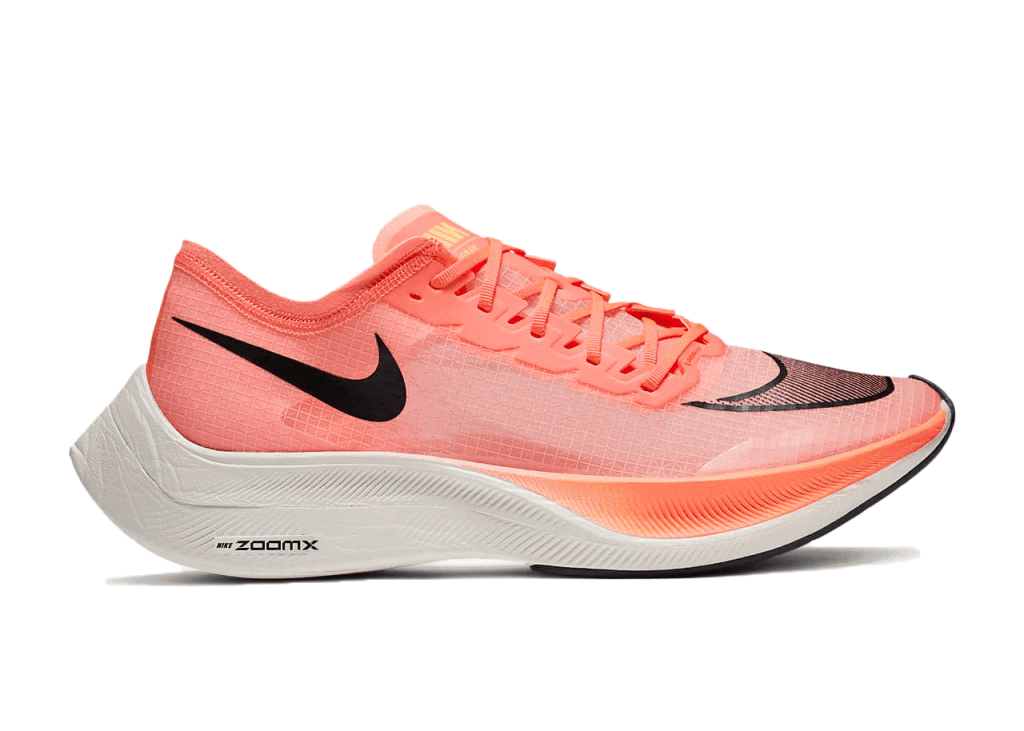
I wanted to love these shoes and I’ll be first to admit this is one such shoe that could very well be a case of it’s me not the shoe. Regardless, I just could never really make them flow for me after 10-12 kms of running.
Even when I didn’t like them in training and had already run terribly in them for a couple of races, the efficiency of it at very fast paces during testing which absolutely was incredibly fast and the marketing hype around the shoes convinced me to keep wearing them in races. Ultimately, the continued pattern of falling apart on the run once my pace was slowing led to a dramatic break up and I hid these shoes deep in the cupboard to stop temping me back to the dark side .
In saying that, would I still use this shoe in a fresh 5-10km running race, or an ITU event and didn’t care about getting injured? Absolutely yes. They’re so fast but that speed comes at a high risk of injury for a lot of runners.
Contrary to most people who spring up and down on the ultra spongy Zoom X foam for 30 seconds and pronounce to one and all that the shoe the fastest shoe they’ve ever used, I’ve never been a huge fan of the foam. Primarily from an injury prevention perspective. I’ve seen too many athletes biomechanics turn into a fast moving horror movie. It’s fast but asking for trouble and eventually a lot of athletes come unstuck. This is partly due to the super squishy Nike X foam and partly because Nike seems to be really into making an overly exaggerated banana shape of the inside edge of the sole. This wouldn’t be such a problem with a less compressive foam, but with the current shaping and foam combined, over pronation gets a little cray cray. As the shoe wears quickly, this becomes more of a problem, not less of a problem, unlike most other shoes who tend to wear the outside of the shoe faster than the medial aspect.
The passion for the shoe is so strong in people pre-race and often even post-race until about a week after their goal marathon where an achilles, knee or hip injury has mysteriously appeared and they’re out of running action for a month or five. The foam can also cause a double bounce effect for lighter runners at slower paces than 3.40/km, reverberating through their legs and leaving the quads pretty wrecked by the end of a marathon. Not such a problem for heavier runners and certainly not a problem if you can keep the pace really high like all the runners Nike sponsor. Athletes who have the cash to train in the shoes and cycle through pair after pair, and can learn how to run in their shoes would be wise to do so as it does require technique changes from the traditional race shoe in order to make it really work for the runner.
With this shoe Nike fixed the slippery outer sole issue of the Nike 4% and older Zoom Fly models superbly. The heel cup ridge design is cool and works well if the shoe fits very well length wise. Not so well if the shoe is even slightly too big. The tongue and lacing design is not particularly friendly for running and straight up cruel towards triathletes. The Next % does not work well with elastic laces.
This shoe still gets a high score mainly because it does test so freaking fast at high speeds and some pro triathletes I know run beautifully in this shoe without the implosion of run form that others experience.
Asics Metaracer- 7.8/10 Sent to test
A light weight, responsive and comfortable traditional racing flat but the design seemingly ignores all the technology breakthroughs of the last few years that make the top crop of marathon shoes so fast.

Yeah I know Jan Frodeno lay utter smack down in these shoes in Kona 19 but Jan could run fast in a set of your Uncle’s Dunlop Volleys that he saves for Sunday mowing sessions.
Interestingly, at least for the way I run, other Asics shoe models tested faster that aren’t suppose to be their premium racer. This is not really that much of an insult towards the Metaracer because as I’ve mentioned before some of their new affordable models like the Evoride test damn fast.
There is nothing to dislike about the shoe. 6-7 years ago this would have been a cream of the crop racing flat. It’s just that this shoe ignores what is making some of the most efficient marathon racers so efficient. The foam is cushioned yet very minimal. So minimal that you’re going to feel muscle break down a lot sooner than a lot of the shoes listed above. You would really want to have the training mileage overflowing from under your belt or the legs are going to feel like they’ve been taken to with a baseball bat at 35kms.
In all my testing, cadence naturally went up for race pace compared to the above listed carbon plated shoes. Perhaps with a lower carry, really high cadence runner (think classic Japanese marathoner) this shoe could really work.
The carbon plate didn’t seem carbon in my prototype version but maybe it’s changed to carbon in the now publicly available models.
I could train in these shoes a lot as I like minimal shoes, especially for long slower training, but I don’t enjoy it when doing tempo or faster running.
If Asics want to truly compete in the carbon plate market they need to scrap this shoe and work with the NovaBlast design (review coming soon) OR use the same materials of the Metaracer but with all the shaping and sole size of the EvoRide.
My promise to readers is to keep these reviews as honest and as objective as possible. This inevitably leads to less shoes being sent from shoe companies. To help me test the latest running shoes being released please consider a small donation. The more donated, the more shoes that will be tested and the more time I can spend testing. Also, tag me in social media posts of shoes you would like me to test or message direct. Thank you!
 Please contact:
Please contact: